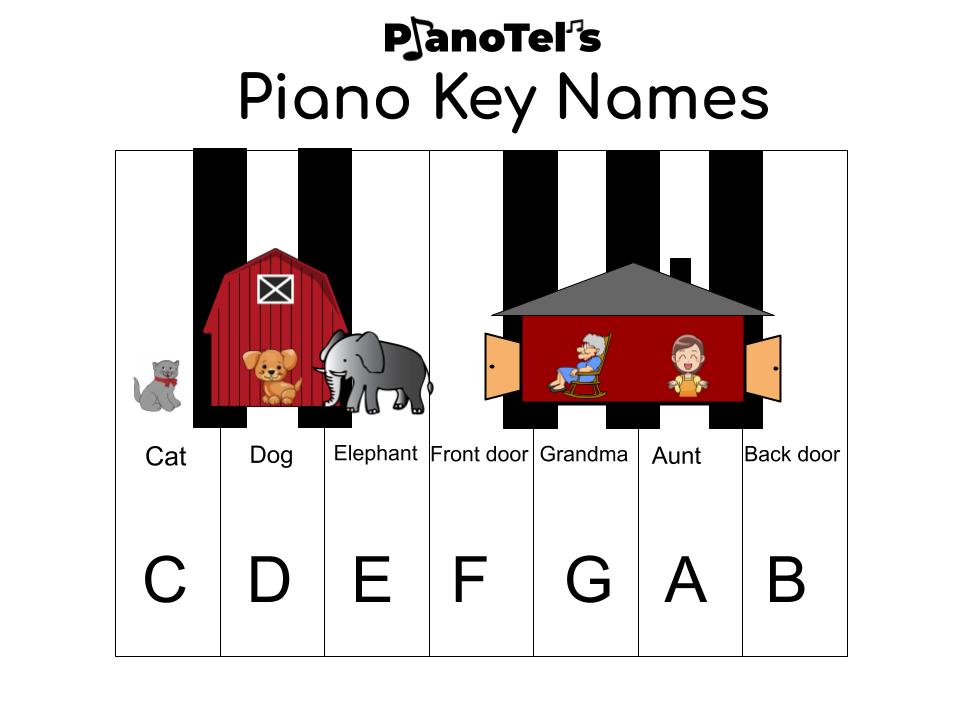Learning the piano keys on the keyboard? Here is an easy way to learn your piano keys!
Piano Key Names.pdf (482 downloads)

To appreciate what this visual means, you will want to hear the story that goes with it!
What’s the story that goes with the piano key names?
If you look closely, you will find a story on each piano keyboard! The piano has barns and houses. The barn (a set of 2 black keys) is where the dog lives. The cat likes to stay outside and catch all the mice. The elephant, of course, doesn’t fit in the barn! So he stays in the yard. Then, you can walk across the yard (the two white keys without any black key in between) to the front door. Once you knock and go in, Grandma is the first one to give you a big hug! Then, you are surprised to find your aunt visiting Grandma’s house as well! You can go out the back door on your way home.
Naming the White Keys
This visual and story is perfect for teaching the white key names of the piano keyboard. Each of the set you see here repeats itself over and over again on the piano. But once you can relate the keys to objects and story that you are familiar with, the brain latches on and it makes it much easier to remember the key name!
C-D-E-F-G-A-B make up the musical alphabet. Each of the letters represent a tone in music. Each tone can be repeated, higher and lower. Which is why you have a repeat of note names on the keyboard! For example, a C that is played on the keyboard sounds a tone. The tone can be found again, 8 notes higher on the keyboard. It is the same tone, just higher. You can continue to find the same tone on the piano until you run out of keyboard.
It is helpful to orient yourself on the keyboard. There are 52 white keys on the keyboard. These white keys can be differentiated by the groups of black keys on the keyboard. There are 36 black keys, and these are grouped into 2’s and 3’s. Once you can identify the groups, then you can start figuring out the keys.
The groups of 2 are represented in this visual by a barn. A barn is smaller than a house (at least, we hope, lol!) and thus a group of 3 black keys represents the grandma’s house.
The key to the immediate left of the group of 2 (the barn) is a C. The key between the group of two black keys is a D. The key to the immediate right of the set of 2 black keys is an E.
The white key to the immediate left of the group of 3 black keys is an F. The next key is a G. The next key is an A. The final key to the right of the group of 3 is a B.
Then the pattern repeats!
Keyboard Layout
From one C to another C is an octave. Every 8 keys on the keyboard will be an octave. There are 7 octaves on a full keyboard with 88 keys.
You will notice that the keyboard does not always begin on a C. Sometimes the keyboard will begin and end on a C, as is the case for a 49 and 61 key keyboard. But a 76 key keyboard starts on an E and ends on a G. The 88 key keyboard (which is considered a full keyboard) begins on an A and ends on a C.
Whole Step and Half Steps
In order to name the black keys, we need to know what a whole step and a half step is. Making this really simple, a half step is going from one key to the next key — whether it’s black or white. It could be from a black key to a white key. It could be a white key to a white key (such as E to F, or B to C). But a half step is from one key to the next key.
In real musical terms they call it a semitone. A semitone is the smallest interval we use. We also can call it half step.
How many halves does it take to get a whole? Two! Therefore, it takes 2 half steps to make a whole step! So, if you want to find a whole step, you have to make 2 half steps. Therefore, a whole step would be from C to D.
To keep it straight, just remember that it takes 2 half steps to make a whole step.
Now that you understand whole steps and half steps, let’s look at naming the black keys.
Naming the Black Keys
The black keys on a keyboard are kind of the side kick to the white keys. Each of the white keys are a tone in music. The black key just represents if that tone is a half tone higher (called a sharp), or a half tone lower (called a flat). It is still tied to the white key and the tone that that key is.
Which is why there is not a new name for each black key. They carry the name of the key next to them and include either a sharp (#) or a flat (b). So, the black key next to the C could be a C# (named a C sharp). It would be considered a sharp because it is a half tone higher than C.
You can also look at it a different way. The black note is also next to the D. But it is a half tone lower than the D. So we could call is a Db (named a D flat).
So, the black key between the C and the D could be a C# (C sharp) or a Db (D flat).
One way to help you remember, is from dummies.com:
A knife is sharp and lies on the right side of the plate.
A napkin is flat and lies on the left side of the plate.
You know which one it is according to the music written. There are other symbols, called key signatures, that will help you in that area. Though just to be sure that you understand a C# and a Db are the exact same note. They just name it different according to the key signature written in the music. All you need to know for now, is that key signatures helps make things a little clearer for the pianist in knowing what to expect in them written music.
Related Articles:
The Staff – Music Theory for Kids
Learn Treble and Bass Clef Lines and Spaces
Tel loves her life as a piano player, a piano teacher, and a mom. Amid piano blogging, piano teaching, and piano playing, she loves a chance to fit in a good exercise class, volunteer at her kids’ school and at her church, and go on long dates with her husband. Full bio at About Tel.


